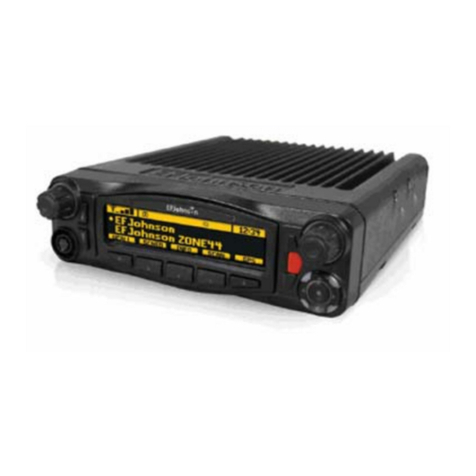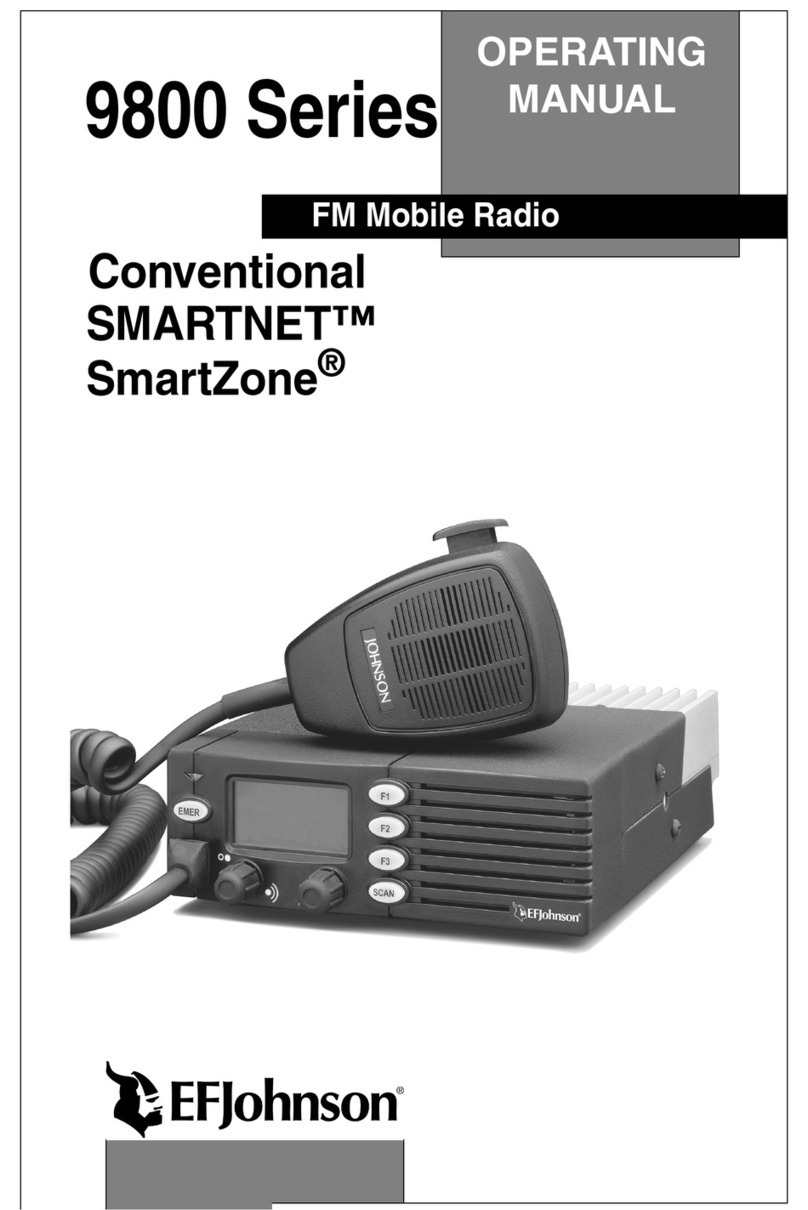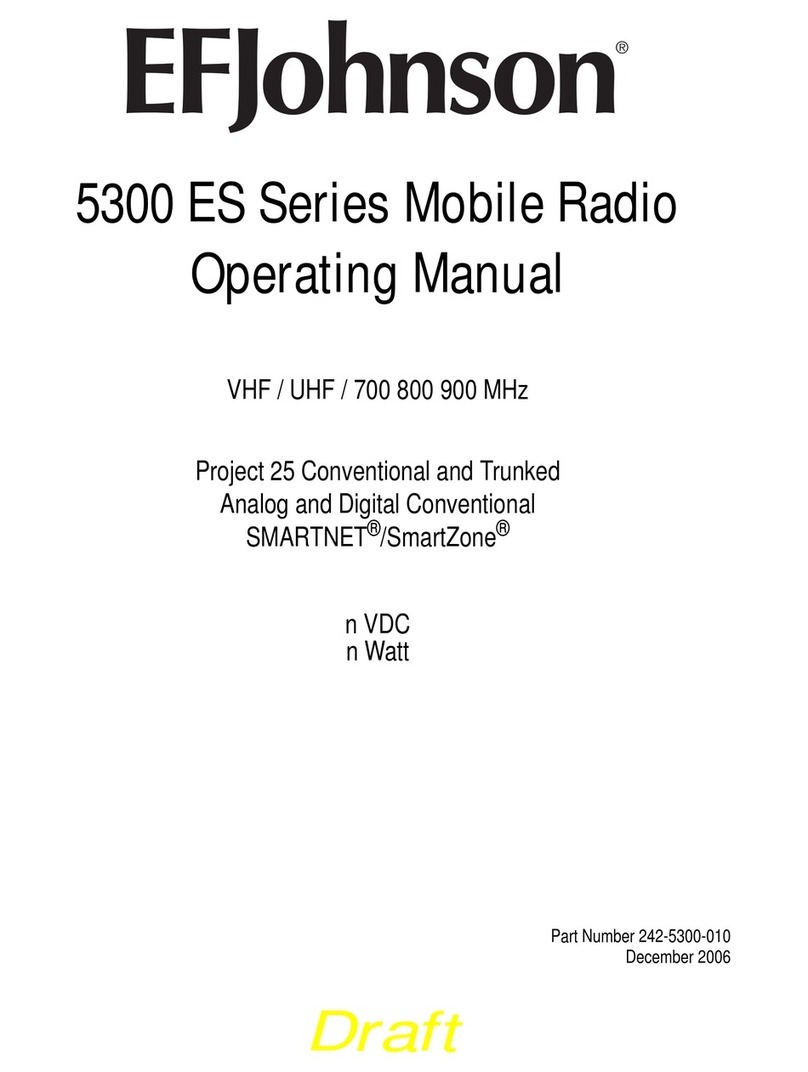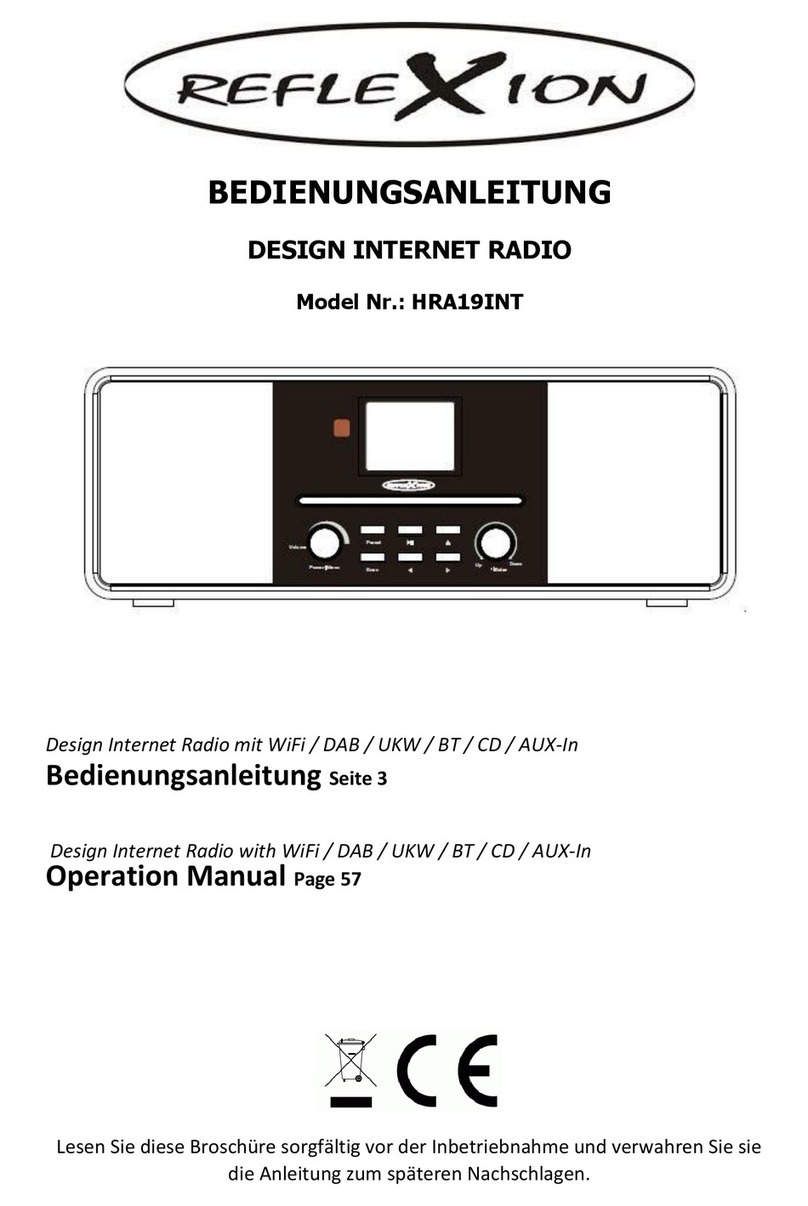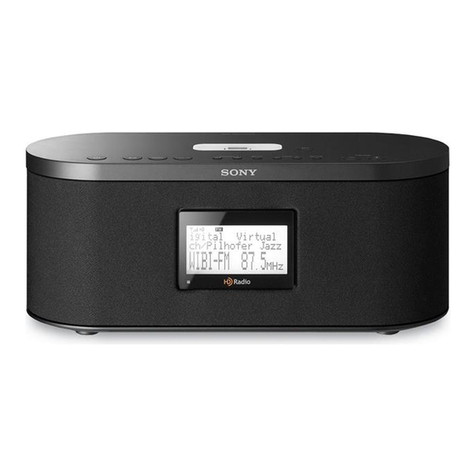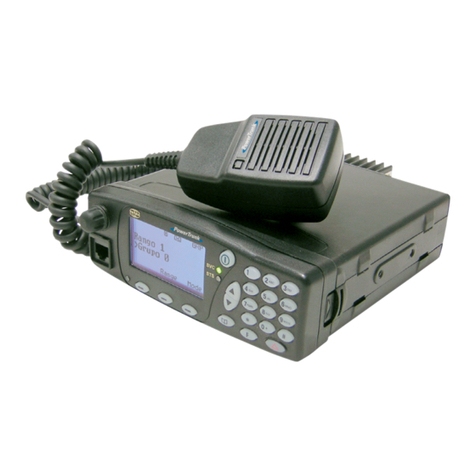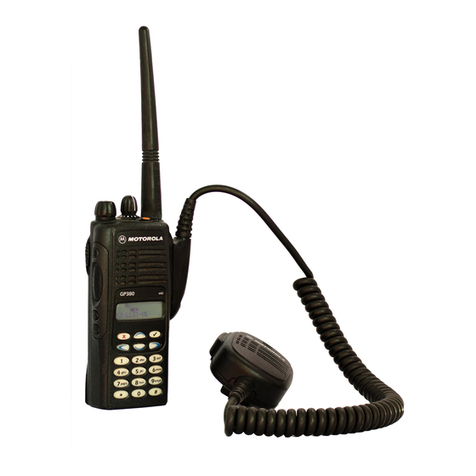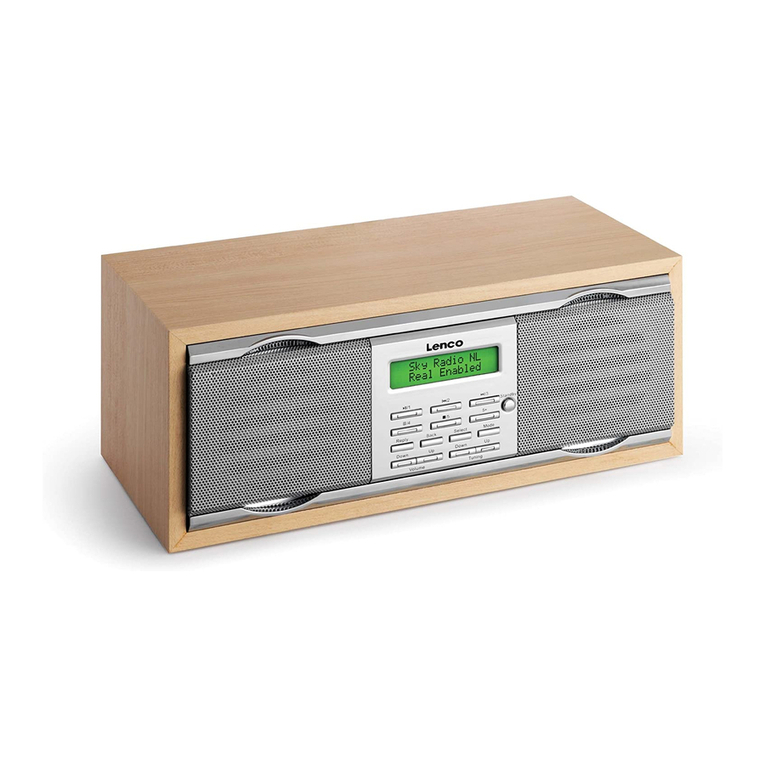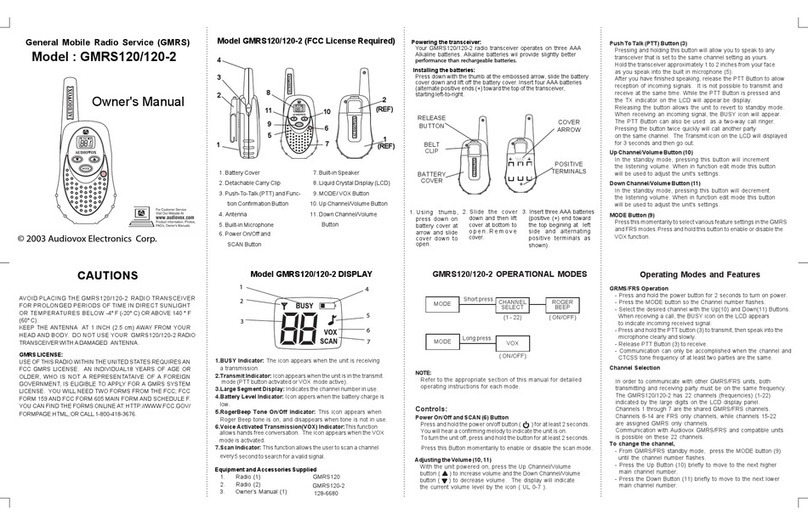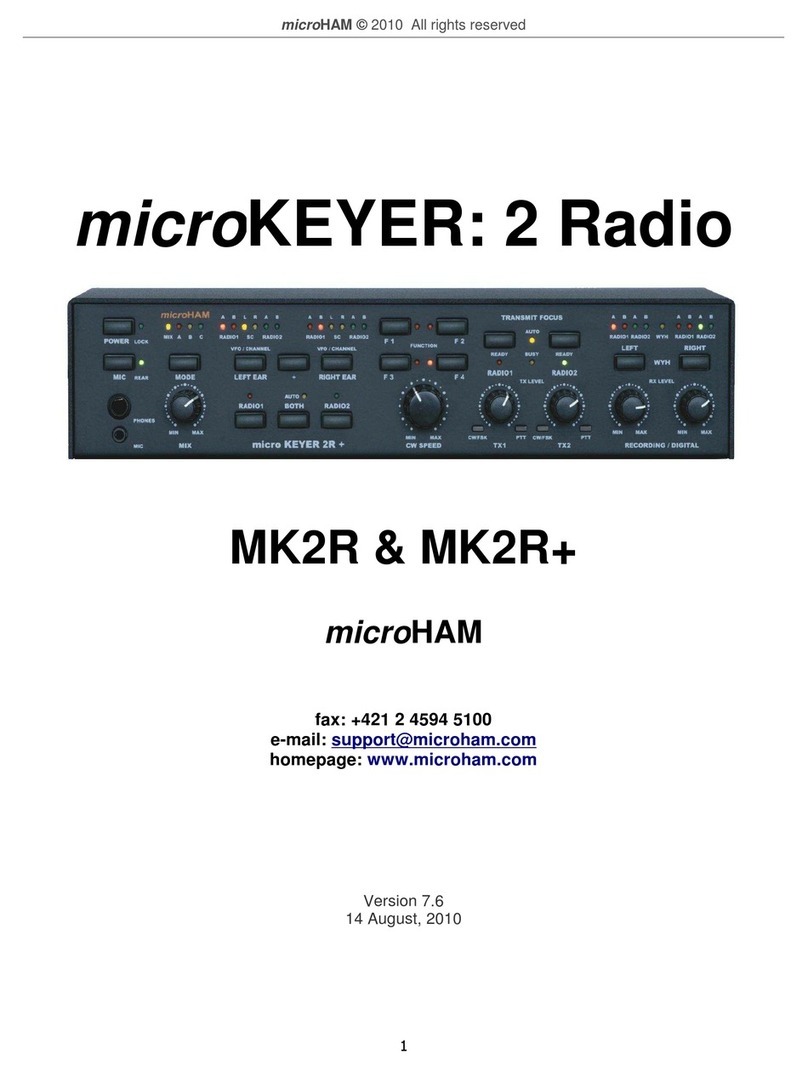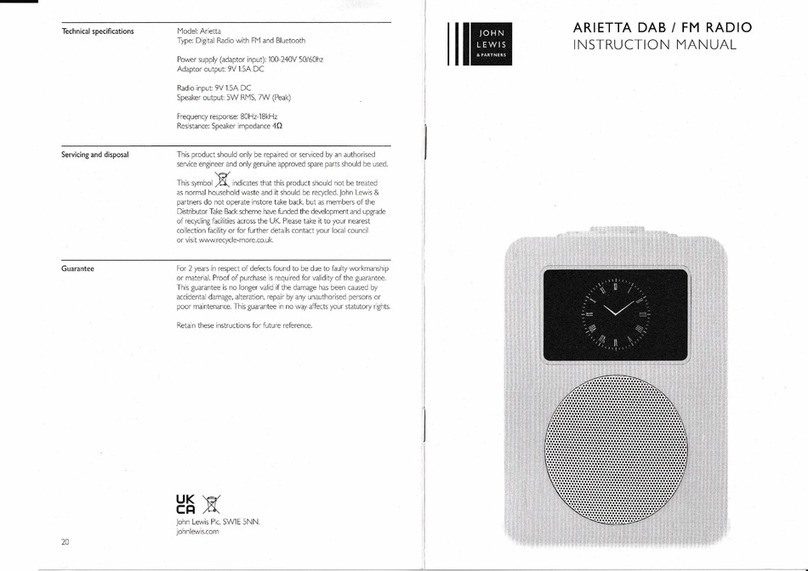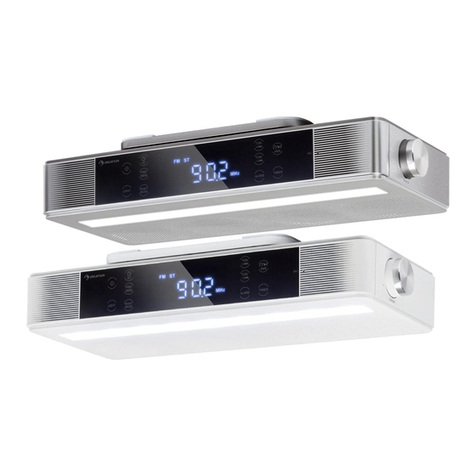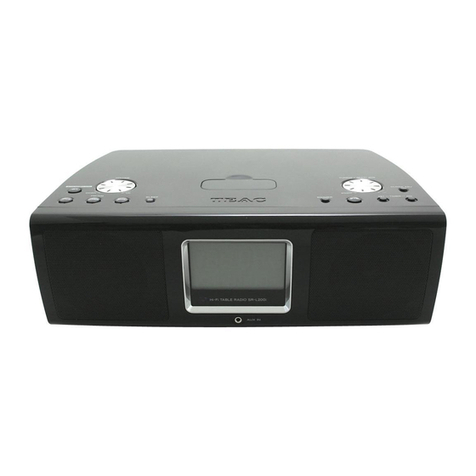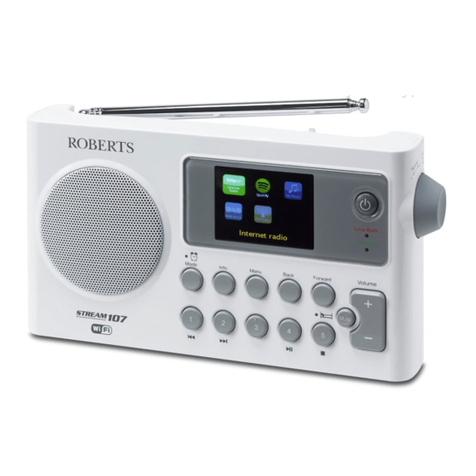E.F. Johnson Company LTR-Net 002-9803-601 User manual

LTR-Net™
OPERATING
MANUAL
9800 Series
Trunked Mobile Radio
98x3/98x6
LTR-NET™ Mobile


LAND MOBILE PRODUCT WARRANTY - The manufacturer’s
warranty statement for this product is available from your product
supplier or from EFJohnson, 299 Johnson Avenue, Box 1249,
Waseca, MN 56093-0514. Phone (507) 835-6222.
Copyright© 1999 by the E.F. Johnson Company
E.F. Johnson Company, which was founded in 1923, designs, manu-
factures, and markets radio communication products, systems, and
services worldwide. E.F. Johnson produces equipment for land
mobile radio and mobiletelephone services which include business,
industrial, government, public safety, and personal users.
Viking Head/EFJohnson logo, LTR-Net™, LTR®, and Call Guard®
are trademarks of the E.F. Johnson Company. All other company
and/or product names used in this manual are trademarks and/or
registered trademarks of their respective manufacturer.

SAFETY INFORMATION
4
SAFETY INFORMATION
The FCC has adopted a safety standard for human exposure to
RF energy. Proper operation of this radio under normal condi-
tions results in user exposure to RF energy below the Occupa-
tional Safety and Health Act and Federal Communication
Commission limits.
WARNING
DO NOT allow the antenna to touch or come in very close prox-
imity with the eyes, face, or any exposed body parts while the
radio is transmitting.
DO NOT operate the transmitter of a mobile radio when a person
outside the vehicle is within one (1) meter of the antenna.
DO NOT operate the transmitter of a stationary radio (base
station or marine radio) when a person is within one (1) meter of
the antenna.
DO NOT operate the radio in explosive or flammable atmo-
spheres. The transmitted radio energy could trigger blasting caps
or cause an explosion.
DO NOT operate the radio without the proper antenna installed.
DO NOT allow children to operate or play with this radio.
NOTE: The above warning list is not intended to include all
hazards that may be encountered when using this radio.
This device complies with Part 15 of the FCC rules. Operation is
subject to the condition that this device does not cause harmful
interference. In addition, changes or modifications to this equip-
ment not expressly approved by EFJohnson could void the user’s
authority to operate this equipment (FCC rules, 47CFR Part
15.19).

SAFETY INFORMATION
5
FCC EXPOSURE LIMITS
This mobile radio transceiver was tested by the manufacturer
with an appropriate antenna in order to verify compliance with
Maximum Permissible Exposure (MPE) limits set under Section
2.1091 of the FCC Rules and Regulations. The guidelines used in
the evaluation are derived from Figure 1 (B) titled “Limits For
General Population/Uncontrolled Exposure” which is from FCC
report OET bulletin #65.
Figure 1
FCC Limits for Maximum Permissible Exposure (MPE)
(A) Limits For Occupational/Controlled Exposure
Frequency Range
(MHz)
Electric Field
Strength (E)
(V/m)
MagneticField
Strength (H)
(A/m)
PowerDensity
(S)
(mW/cm22)
Averaging
Time |E|2, |H|2,
S (minutes)
0.3-3.0 614 1.63 (100)* 6
3.0-30 1842/f 4.89/f (900/f2)* 6
30-300 61.4 0.163 1.0 6
300-1500 -- -- f/300 6
1500-100,000 -- -- 5 6
(B) Limits For General Population/Uncontrolled Exposure
Frequency Range
(MHz)
Electric Field
Strength (E)
(V/m)
MagneticField
Strength (H)
(A/m)
PowerDensity
(S)
(mW/cm22)
Averaging
Time |E|2, |H|2,
S (minutes)
0.3-1.34 614 1.63 (100)* 30
1.34-30 824/f 2.19/f (180/f2)* 30
30-300 27.5 0.073 0.2 30
300-1500 -- -- f/1500 30
1500-100,000 -- -- 1.0 30
f = Frequency in MHz *Plane-wave equivalent power density

SAFETY INFORMATION
6
Figure 2 lists the antenna whips and bases recommended for
use in each frequency range. Each model of this radio was tested
with the appropriate antenna listed. The antenna was mounted in the
center of the roof of a domestic manufactured 4-door passenger
sedan. The radio manufacturer has determined that the user and
service personnel should remain one (1) meter in distance away
from the antenna when transmitting. By maintaining this distance,
these individuals are not exposed to radio frequency energy or
magnetic fields in excess of the guidelines set forth in Figure 1.
NOTE: If the installer or user changes the type or location of the
antenna, they should be aware of the MPE guidelines shown in
Figure 1 and take measures to comply with those guidelines.
Figure 2
Recommended Antenna Whips and Bases
(Antenna Manufacturer - Antenna Specialists)
Frequency Whip Model No. Base Model No.
136-144 MHz ASPJ1415 KM220
144-152 MHz ASPA1415 KM220
152-162 MHz ASPB1415 KM220
162-174 MHz ASPC1415 KM220
400-430 MHz ASPE1615 KM220
430-470 MHz ASPD1615 KM220
470--512 MHz ASPF1615 KM220
806-869 MHz ASPA1855 KM220
890-960 MHz ASPG1865 KM220

TABLE OF CONTENTS
7
TABLE OF CONTENTS
SAFETY INFORMATION. . . . . . . . . . . . . . . . . . . . . . . . . . . . . . . . . . . . .4
QUICK REFERENCE GUIDE . . . . . . . . . . . . . . . . . . . . . . . . . . . . . . . . .9
FEATURES . . . . . . . . . . . . . . . . . . . . . . . . . . . . . . . . . . . . . . . . . . . . . . .10
General Features. . . . . . . . . . . . . . . . . . . . . . . . . . . . . . . . . . . . . . . . . .10
LTR-Net Features. . . . . . . . . . . . . . . . . . . . . . . . . . . . . . . . . . . . . . . . .10
LTR Features . . . . . . . . . . . . . . . . . . . . . . . . . . . . . . . . . . . . . . . . . . . .10
Conventional Features . . . . . . . . . . . . . . . . . . . . . . . . . . . . . . . . . . . . .10
CONTROLS AND DISPLAY. . . . . . . . . . . . . . . . . . . . . . . . . . . . . . . . .11
Front Panel Controls. . . . . . . . . . . . . . . . . . . . . . . . . . . . . . . . . . . . . . .11
Rear Panel Jacks and Connectors. . . . . . . . . . . . . . . . . . . . . . . . . . . . .13
Display Description . . . . . . . . . . . . . . . . . . . . . . . . . . . . . 14
GENERAL OPERATION . . . . . . . . . . . . . . . . . . . . . . . . . . . . . . . . . . . .15
Power-Up Sequence . . . . . . . . . . . . . . . . . . . . . . . . . . . . . . . . . . . . . . .15
Determining Volume Level . . . . . . . . . . . . . . . . . . . . . . . . . . . . . . . . .15
Backlight Operation . . . . . . . . . . . . . . . . . . . . . . . . . . . . . . . . . . . . . . .16
System/Group Display Modes . . . . . . . . . . . . . . . . . . . . . . . . . . . . . . .16
Selecting the System and Group . . . . . . . . . . . . . . . . . . . . . . . . . . . . .17
Setting Squelch Control . . . . . . . . . . . . . . . . . . . . . . . . . . . . . . . . . . . .18
Microphone Off-Hook Detect . . . . . . . . . . . . . . . . . . . . . . . . . . . . . . .18
LTR-Net, LTR, and Conventional Operation . . . . . . . . . . . . . . . . . . .19
GENERAL FEATURES . . . . . . . . . . . . . . . . . . . . . . . . . . . . . . . . . . . . .20
Bank Select. . . . . . . . . . . . . . . . . . . . . . . . . . . . . . . . . . . . . . . . . . . . . .20
Call Indicator . . . . . . . . . . . . . . . . . . . . . . . . . . . . . . . . . . . . . . . . . . . .21
Emergency Switch . . . . . . . . . . . . . . . . . . . . . . . . . . . . . . . . . . . . . . . .21
Encryption . . . . . . . . . . . . . . . . . . . . . . . . . . . . . . . . . . . . . . . . . . . . . .21
Function (FCN) Switch . . . . . . . . . . . . . . . . . . . . . . . . . . . . . . . . . . . .22
Home System/Group Select . . . . . . . . . . . . . . . . . . . . . . . . . . . . . . . . .22
Horn Alert. . . . . . . . . . . . . . . . . . . . . . . . . . . . . . . . . . . . . . . . . . . . . . .23
Option Select . . . . . . . . . . . . . . . . . . . . . . . . . . . . . . . . . . . . . . . . . . . .24
Power Turn-Off Delay . . . . . . . . . . . . . . . . . . . . . . . . . . . . . . . . . . . . .24
Proceed (Clear-To-Talk) Tone. . . . . . . . . . . . . . . . . . . . . . . . . . . . . . .25
Receive-Only Groups. . . . . . . . . . . . . . . . . . . . . . . . . . . . . . . . . . . . . .25
Stealth Mode. . . . . . . . . . . . . . . . . . . . . . . . . . . . . . . . . . . . . . . . . . . . .26
Time-Out Timer . . . . . . . . . . . . . . . . . . . . . . . . . . . . . . . . . . . . . . . . . .26
Tone Select. . . . . . . . . . . . . . . . . . . . . . . . . . . . . . . . . . . . . . . . . . . . . .26
Transmitter Thermal Foldback. . . . . . . . . . . . . . . . . . . . . . . . . . . . . . .27
STANDARD GROUP CALLS. . . . . . . . . . . . . . . . . . . . . . . . . . . . . . . .27
General . . . . . . . . . . . . . . . . . . . . . . . . . . . . . . . . . . . . . . . . . . . . . . . . .27
Placing a Standard Group Call. . . . . . . . . . . . . . . . . . . . . . . . . . . . . . .27
Receiving a Standard Group Call. . . . . . . . . . . . . . . . . . . . . . . . . . . . .29
TELEPHONE CALLS. . . . . . . . . . . . . . . . . . . . . . . . . . . . . . . . . . . . . . .29
General . . . . . . . . . . . . . . . . . . . . . . . . . . . . . . . . . . . . . . . . . . . . . . . . .29

TABLE OF CONTENTS
8
Placing Telephone Calls. . . . . . . . . . . . . . . . . . . . . . . . . . . . . . . . . . . .29
Receiving a Telephone Call . . . . . . . . . . . . . . . . . . . . . . . . . . . . . . . . .30
Landside-Originate Telephone Calls . . . . . . . . . . . . . . . . . . . . . . . . . .31
LTR-NET AUXILIARY CALLS . . . . . . . . . . . . . . . . . . . . . . . . . . . . . . .31
General . . . . . . . . . . . . . . . . . . . . . . . . . . . . . . . . . . . . . . . . . . . . . . . . .31
Placing LTR-Net Auxiliary Calls. . . . . . . . . . . . . . . . . . . . . . . . . . . . .32
Receiving Auxiliary Calls . . . . . . . . . . . . . . . . . . . . . . . . . . . . . . . . . .32
OPTION SWITCHES AND MENU MODE . . . . . . . . . . . . . . . . . . . . .33
Option Switches . . . . . . . . . . . . . . . . . . . . . . . . . . . . . . . . . . . . . . . . . .33
Menu Mode Introduction . . . . . . . . . . . . . . . . . . . . . . . . . . . . . . . . . . .33
Using Menu Mode . . . . . . . . . . . . . . . . . . . . . . . . . . . . . . . . . . . . . . . .35
SYSTEM AND GROUP SCANNING . . . . . . . . . . . . . . . . . . . . . . . . . .35
General . . . . . . . . . . . . . . . . . . . . . . . . . . . . . . . . . . . . . . . . . . . . . . . . .35
Scan List Programming . . . . . . . . . . . . . . . . . . . . . . . . . . . . . . . . . . . .38
Scan Delay and Continue Timers. . . . . . . . . . . . . . . . . . . . . . . . . . . . .39
Transmitting In The Scan Mode. . . . . . . . . . . . . . . . . . . . . . . . . . . . . .39
LTR-NET AND LTR FEATURES. . . . . . . . . . . . . . . . . . . . . . . . . . . . .40
Transmit Inhibit . . . . . . . . . . . . . . . . . . . . . . . . . . . . . . . . . . . . . . . . . .40
Calls on Priority ID Codes . . . . . . . . . . . . . . . . . . . . . . . . . . . . . . . . . .41
Telephone Group Select. . . . . . . . . . . . . . . . . . . . . . . . . . . . . . . . . . . .41
LTR-NET FEATURES . . . . . . . . . . . . . . . . . . . . . . . . . . . . . . . . . . . . . .42
LTR-Net Standard and Special Calls . . . . . . . . . . . . . . . . . . . . . . . . . .42
Busy Queuing. . . . . . . . . . . . . . . . . . . . . . . . . . . . . . . . . . . . . . . . . . . .42
Roaming . . . . . . . . . . . . . . . . . . . . . . . . . . . . . . . . . . . . . . . . . . . . . . . .43
LTR FEATURES . . . . . . . . . . . . . . . . . . . . . . . . . . . . . . . . . . . . . . . . . . .44
Standard Group Calls . . . . . . . . . . . . . . . . . . . . . . . . . . . . . . . . . . . . . .44
Telephone Calls . . . . . . . . . . . . . . . . . . . . . . . . . . . . . . . . . . . . . . . . . .44
CONVENTIONAL FEATURES. . . . . . . . . . . . . . . . . . . . . . . . . . . . . . .44
Monitoring Before Transmitting . . . . . . . . . . . . . . . . . . . . . . . . . . . . .44
Transmit Disable On Busy . . . . . . . . . . . . . . . . . . . . . . . . . . . . . . . . . .46
Talk-Around. . . . . . . . . . . . . . . . . . . . . . . . . . . . . . . . . . . . . . . . . . . . .46
Call Guard Squelch . . . . . . . . . . . . . . . . . . . . . . . . . . . . . . . . . . . . . . .47
MISCELLANEOUS. . . . . . . . . . . . . . . . . . . . . . . . . . . . . . . . . . . . . . . . .47
Supervisory Tones . . . . . . . . . . . . . . . . . . . . . . . . . . . . . . . . . . . . . . . .47
LTR-Net Special Call Tones . . . . . . . . . . . . . . . . . . . . . . . . . . . . . . . .49
LTR Telephone Call Tones . . . . . . . . . . . . . . . . . . . . . . . . . . . . . . . . .49
Display Messages. . . . . . . . . . . . . . . . . . . . . . . . . . . . . . . . . . . . . . . . .50
Menu Mode Messages . . . . . . . . . . . . . . . . . . . . . . . . . . . . . . . . . . . . .52
System Operator Programming . . . . . . . . . . . . . . . . . . . . . . . . . . . . . .53
Speaking Into Microphone. . . . . . . . . . . . . . . . . . . . . . . . . . . . . . . . . .53
Operation At Extended Range . . . . . . . . . . . . . . . . . . . . . . . . . . . . . . .54
Preventing Battery Discharge. . . . . . . . . . . . . . . . . . . . . . . . . . . . . . . .54
Licensing . . . . . . . . . . . . . . . . . . . . . . . . . . . . . . . . . . . . . . . . . . . . . . .54
Transceiver Service . . . . . . . . . . . . . . . . . . . . . . . . . . . . . . . . . . . . . . .55

QUICK REFERENCE GUIDE
9
QUICK REFERENCE GUIDE
Power On/Off - Press on-off /volume control.
Set Volume Level - Rotate on-off/volume control.
Change System or Group - Press Select switch to enable system or
group select mode (indicated by ←/→ or __). Then rotate Select
switch to select desired system or group (see page 17).
Select Menu Mode - Press FCN twice or Menu switch and then
rotate/press Select switch as required to display/select desired
parameter (see page 33).
Select Home System/Group - Press FCN then Select sw. or HOME
Scan On/Off - Press SCAN switch. Scan on = , Scanning
occurring = scrolling underline (see page 35).
Program System or Group Scan List- Press Select switch to enable
system or group select mode (same as when changing system or
group), then press A/D switch. System in list = , Group in
list = (see page 38).
Set Squelch Level (Conv. Only) - Press FCN then rotate Select
switch with conventional system selected (see page 18).
Monitor Before Transmitting (Conv. Only) - Take microphone off-
hook to enable monitor mode (indicated by ). Channel is busy
if indicator is green or someone is talking (see page 44).
On-Off/Volume
System Scan
List
Phone/
Aux Call
Group Scan
List
Option
Scan Call
Monitor
Red - Transmit
Green - Busy Conv. Group (Channel)
Amber - Transmit (Reduced Pwr)
Select Switch
(Press/Rotate) (Press/Rotate)
Horn
Encrypt

FEATURES
10
FEATURES
General Features
•Up to approximately 99 systems with up to 99 groups each
•LTR-Net™, LTR®, and conventional operation
•Unique 8-character system and group identification tags
•System and group scan
•User programmable system and group scan lists
•Menu mode to control various functions
•Five programmable option switches
•Up to 16 banks selectable
•Proceed (clear-to-talk) tone
•Call indicator
•Horn alert
•Emergency quick select switch
•Companding (optional)
•Encryption (optional)
•Receive-only groups
LTR-Net Features
•Roaming (automatic locality search)
•Standard (mobile-to-mobile) calls
•Special calls including telephone, unique ID, and directed group
•Busy queuing of special calls by radio system
•Transmit inhibit
•Receive priority calls
LTR Features
•Standard and telephone calls
•Transmit inhibit
•Receive priority calls
Conventional Features
•Busy indicator
•Talk-around
•User-adjustable squelch level
•Call Guard® squelch control
•Transmit disable on busy
NOTE: System operator programming determines the availability of many
of the preceding features.

CONTROLS AND DISPLAY
11
CONTROLS AND DISPLAY
Front Panel Controls
On-Off Volume - Pressing this knob turns power on and off. The
vehicle ignition switch may also control power as described in
“Power Turn-Off Delay” on page 24. Rotating this knob sets the
speaker volume (see page 15).
Select Switch - This switch changes the selected system or group and
is also used for other functions such as selecting parameters in the
menu mode. To change the system or group, press this knob to switch
between the system and group select modes, and then rotate it to
increase or decrease the system or group. Refer to “Selecting the
System andGroup”onpage 17andtheFCNswitchdescriptionwhich
follows for more information.
Option Switches - The five front panel option switches can be
programmed by your system operator to control the functions which
follow. Refer to the section indicated for more information. The
keycap usually indicates the function controlled by the switch.
On-Off/Volume Select Switch
Microphone
Jack
Option Switches
Transmit/Busy
Indicator Speaker

CONTROLS AND DISPLAY
12
A/D - Scan list add/delete (see page 38)
BANK - Bank select (see page 20)
EMER - Emergency switch (see page 21)
ENCPT - Encryption select (see page 21)
FCN - Function select (see following description)
HOME - Select home system/group (see page 22)
(Menu) - Menu mode select (see page 33)
AUX - Option select (see page 24)
ROAM - Roam on-off (see page 43)
SCAN - Scan on-off (see page 35)
TEL - Selects telephone group (see “Tel Grp Select” on page 41)
(Blank) - Not used (disabled) or one of above functions
FCN (Function) Switch - This switch, if programmed, selects the
following functions:
Menu Mode Select - Press FCN twice (see page 33)
Home Sys/Grp Select - FCN/press Select switch (see page 22)
Conv Squelch Set - FCN/rotate Select switch (see page 18)
Transmit/Busy Indicator - Indicates the following conditions:
Red - Transmitter keyed, normal power output
Orange - Transmitter keyed, power reduced because internal
temperature is high (see page 27).
Green - Busy conventional group (channel). Refer to “Monitoring
Before Transmitting” on page 44 for more information.
Microphone Jack - Connection point for the microphone.
Microphone Push-To-Talk (PTT) Switch (Not Shown) - Push-
button on the microphone which is pressed to key the transmitter.
Speaker - The internal speaker is located behind the grille. An
optional speaker canbe connectedto the externalspeakerjack located
on the back (see “Speaker Jack” which follows).

CONTROLS AND DISPLAY
13
Rear Panel Jacks and Connectors
Antenna Jack - Miniature UHF jack for connecting the 50-ohm
antenna.
Power Jack - Connection point for the power cable which attaches to
the vehicle battery. A nominal 12-volt DC, negative ground power
source is required.
Speaker Jack - Connection point for an optional external 4.7-ohm,
5-watt speaker. The internal speaker is automatically disabled when a
speaker is plugged into this jack.
Accessory Cable (Not Shown) - This optional cable is used to
connect functions such as ignition switch sense to the transceiver.
Antenna
Jack Speaker
Jack
Power
Jack

CONTROLS AND DISPLAY
14
Display Description
16-Character Message Area - Indicates the selected system and
group (see page 16) and also error conditions and status information.
- Indicates that the displayed system is in the scan list and
scanned normally (see page 38).
- Indicates that the displayed group is in the scan list and
scanned normally (see page 38).
- Indicates that the selected group is programmed for telephone
calls. With LTR-Net operation, it also indicates that the group is
programmed for Auxiliary calls (see page 42).
- Indicates that optional encryption is enabled (see page 21).
- Indicates that the horn alert is enabled (see page 23).
- Indicates that scanning is enabled (see page 35).
System Scan
List Phone/
UID Grp Group Scan
List
Option
Scan Call
16-Character
Message Area Monitor
Encryption Horn Alert

GENERAL OPERATION
15
- Indicates that an option controlled by the AUX switch or
OPTION menu parameter is enabled (see page 24).
- Indicates that a call has been received on a group programmed
for a call indicator (see page 21). To turn this indication off, press
any key.
- Indicates that the monitor mode is enabled. This mode disables
Call Guard squelch and other squelch control features so that all
messages are heard on conventional systems (see page 44).
GENERAL OPERATION
Power-Up Sequence
When power is turned on, the backlight turns on, all segments
in the display are momentarily enabled, and the last seven digits of
the transceiver part number are very briefly displayed. A beep then
sounds (if tones are enabled) and the transceiver is operational.
Determining Volume Level
The relative volume setting can be determined by noting the
position of the index on the volume knob. You may also be able to
enable a reference tone or background noise for use in setting the
volume. Proceed as follows:
•If key press tones are enabled, a short tone sounds when an option
switch is pressed or the Select switch is pressed or rotated.
•If a conventional system is selected, takethe microphone off-hook
and if someone is using the channel, voice is heard. If no one is
using the channel, the squelch control can be adjusted counter-
clockwise as described in “Setting Squelch Control” on page 18
and noise is heard. It is not possible to unsquelch the transceiver
in this manner when an LTR-Net or LTR system is selected.

GENERAL OPERATION
16
Backlight Operation
The display and keypad backlight can be controlled by the
BACKLGTmenuparameter(seepage 33).Thethreestatesthatcanbe
selected are Bright, Dim, and Off. If this menu parameter is not select-
able, the backlight is fixed in one of these states by programming.
System/Group Display Modes
The selected system and group are displayed using either a
Numeric or Alpha display mode. The display mode is selectable if
the S/G DISPL menu parameter is available (see page 33). Other-
wise, it is fixed in one of these modes by programming.
Numeric Mode - In this mode the selected system and group
numbers are displayed on the top line as Sxx and Gxx, and the group
alpha tag is displayed on the bottom line. For example, System 1,
Group 1 (CAR 220) is displayed as follows. The system alpha tag is
not displayed in this mode.
Numeric Display Mode
Alpha Mode - In the alpha mode, the system alpha tag is displayed
on the top line and the group alpha tag is displayed on the bottom
line. For example, a “SECURITY” system and “CAR 220” group
are displayed as follows. The system and group numbers are not
displayed in this mode.
Alpha Display Mode
System Number
Group Number
Group Alpha Tag
System Alpha Tag
Group Alpha Tag

GENERAL OPERATION
17
Selecting the System and Group
The front panel Select switch is used to change the system and
group. Pressing this switch toggles between the system and group
select modes, and rotating it increases or decreases the system or
group.
In the Numeric display mode (see preceding description), the
system select mode is indicated when the arrow points to “Sxx”, and
the group select mode is indicated when it points to “Gxx” (see
following illustration).
Select Mode Indication With Numeric Display
In the Alpha Tag display mode, the system select mode is indi-
cated by an underline in the left-most character position of the
system alpha tag. Likewise, the group select mode is indicated by an
underline in the left-most position of the group alpha tag (see
following illustration).
Select Mode Indication With Alpha Tag Display
System Select
Mode Group Select
Mode
Group Select
Mode
System Select
Mode

GENERAL OPERATION
18
The current mode remains selected until the menu mode is
selected or transceiver power is cycled. The programmed default
mode is then selected if applicable.
Setting Squelch Control
NOTE: This sets the squelch level used for conventional calls. The
squelch level for LTR-Net and LTR calls is preset and not affected by
this adjustment. For more information on operating modes, refer to
page 19.
If conventional systems are programmed, the squelch level can
be set if the FCN option switch is enabled. Proceed as follows:
1. Select a conventional system and a group that is not busy. Take the
microphone off-hook to enable monitoring.
2. Press the FCN switch and then rotate the Select switch as you
would a normal squelch control. Rotate it counterclockwise until
receiver noise is heard and then clockwise slightly past the point
where the noise mutes. The squelch adjust mode is indicated by
“SQUELCH” on the upper line of the display, and the relative
squelch level is indicated by a bar graph on the bottom line.
3. To select the current level and exit this mode, press the Select
switch. This also occurs automatically 2 seconds after no change
is made or 8 seconds after no activity.
4. If both narrow and wide band channels are used, perform this
adjustment on both types because separate settings are maintained.
NOTE: Some readjustment may be required if weak messages are
not heard or unsquelching occurs when no messages are present.
Microphone Off-Hook Detect
Microphone off-hook detection can be disabled by program-
ming. Taking the microphone off-hook then does not disable scan-

GENERAL OPERATION
19
ning (see page 35) or enable conventional channel monitoring (see
page 44).
LTR-Net, LTR, and Conventional Operation
Introduction
Each selectable system can be programmed for LTR-Net, LTR,
or conventional operation. The type of operation that is programmed
is determined by the radio equipment being used by your system
operator. There are only a few differences in operation that are of
concern to the user. These differences are described in the following
information and also noted elsewhere in this manual as required.
LTR-Net and LTR Operation
The LTR-Net and LTR modes provide automatic channel selec-
tion and monitoring before transmitting. Special tones and display
messages indicate busy and out-of-range conditions, and telephone
calls can be placed almost as conveniently as with your home
telephone.
Selecting a system selects a collection of up to 99 groups, and
selecting one of these groups selects an ID code which determines
the type of call (standard group, telephone, or special). In addition,
with standard group calls, it determines the specific mobile or
mobiles being called and what calls are received. Priority groups
may also be programmed which allow additional calls to be received
(see page 41).
The LTR-Net operating mode provides the most operating
features. Exclusive LTR-Net features include roaming and auxiliary
calls such as Unique ID and Directed Group. Calls can be made to
mobiles in your site or some other site. LTR-Net and LTR features
are described starting on page 40.

GENERAL FEATURES
20
Conventional Operation
In the conventional mode, selecting a system selects a specific
radio channel, and selecting a group selects the special Call Guard
squelch coding (if used) and other unique channel parameters such
as call indicator operation. The Call Guard coding determines the
mobile or group of mobiles being called and also the mobiles from
which calls are received (see “Call Guard Squelch” on page 47).
In the conventional mode, a busy condition is detected automat-
ically if the Transmit Disable On Busy feature is used. Otherwise, it
must be detected manually as described in “Monitoring Before
Transmitting” on page 44. Busy and no access conditions cannot be
detected with conventional signaling, so are not indicated by special
tones or display messages. Refer to “Operation At Extended Range”
on page 54 for information on how to determine if an out-of-range
condition may exist.
GENERAL FEATURES
Bank Select
A bank is a collection of selectable systems that have been set
up for a specific application. For example, one bank could be
programmed for operation in Minneapolis and another for operation
in Milwaukee. Each bank is identified by a unique alpha tag, and up
to sixteen banks can be programmed.
Banks are selected by the BANK SEL menu parameter or
BANK option switch. In the menu mode (see page 33), rotate the
Select switch to display “BANK SEL” on the top line and the
current bank is then displayed on the bottom line. Press the Select
switch to change the bank. If using the option switch, when “BANK
SEL” is displayed on the top line, simply press the Select switch to
select the desired bank. If neither the menu parameter nor the option
switch is available, banks are not selectable.
This manual suits for next models
3
Table of contents
Other E.F. Johnson Company Radio manuals
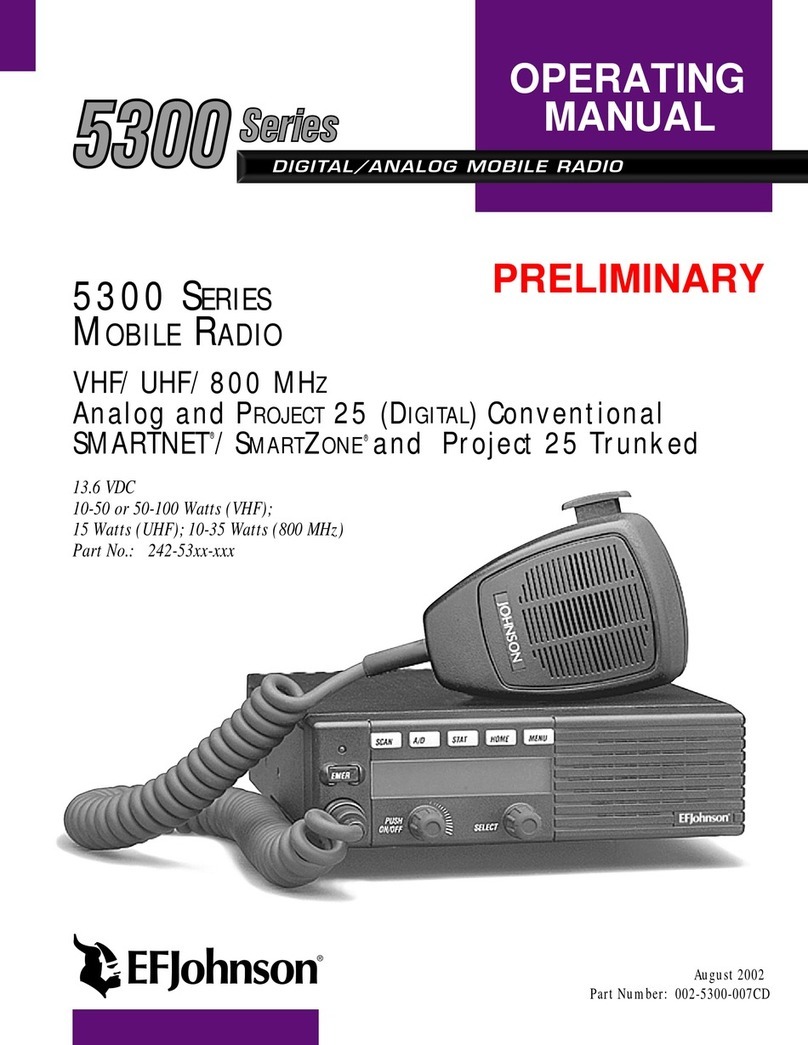
E.F. Johnson Company
E.F. Johnson Company 5300 Series User manual

E.F. Johnson Company
E.F. Johnson Company 5300 Series User manual
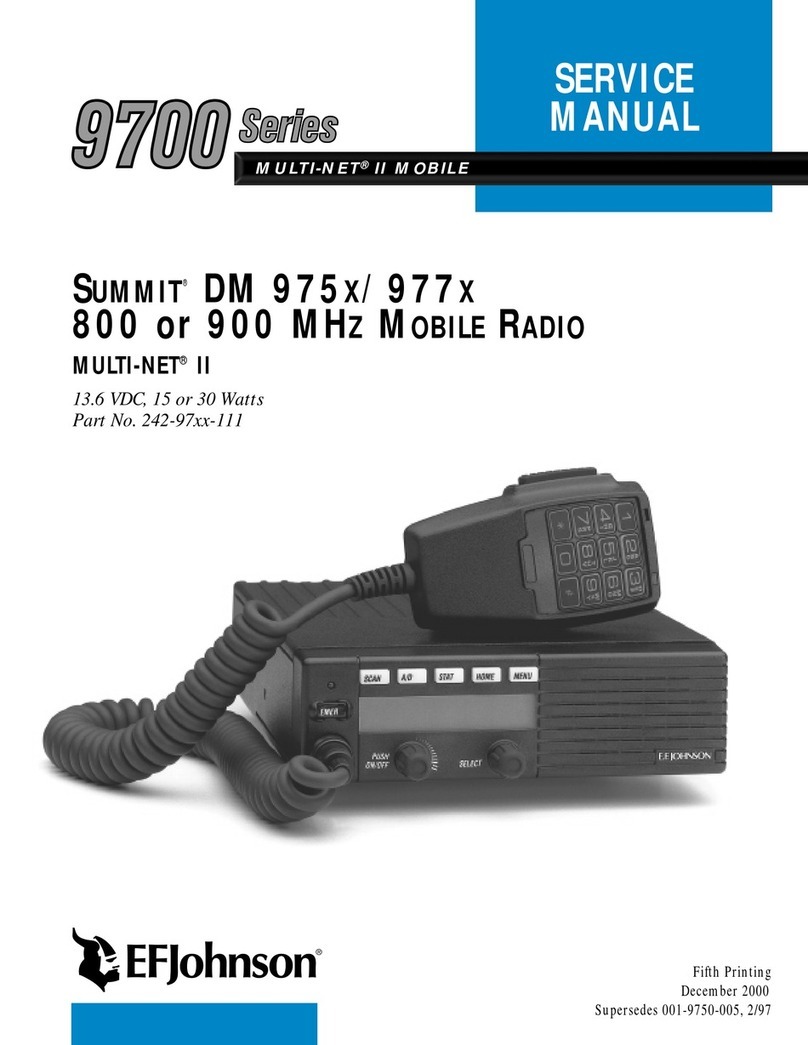
E.F. Johnson Company
E.F. Johnson Company Summit DM 975x User manual
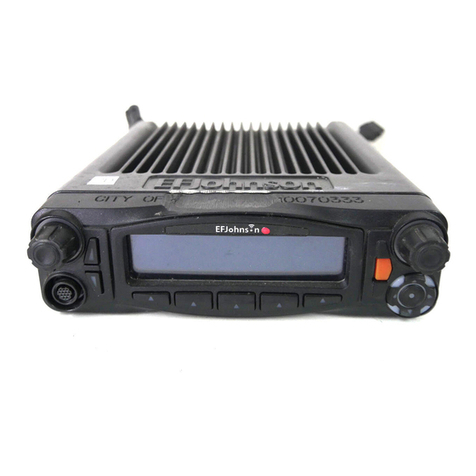
E.F. Johnson Company
E.F. Johnson Company 5300 ES Series User manual

E.F. Johnson Company
E.F. Johnson Company 53SL ES Series User manual
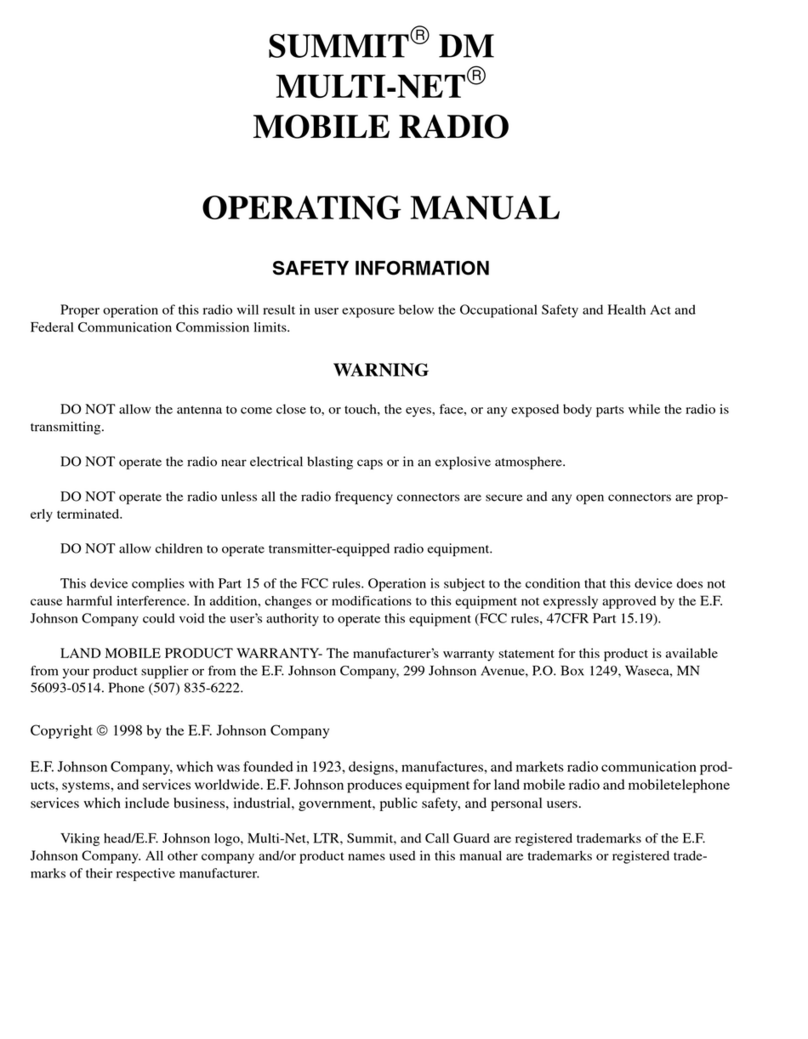
E.F. Johnson Company
E.F. Johnson Company 002-9750-003 User manual

E.F. Johnson Company
E.F. Johnson Company 5300 Series User manual

E.F. Johnson Company
E.F. Johnson Company LTR 98xx User manual
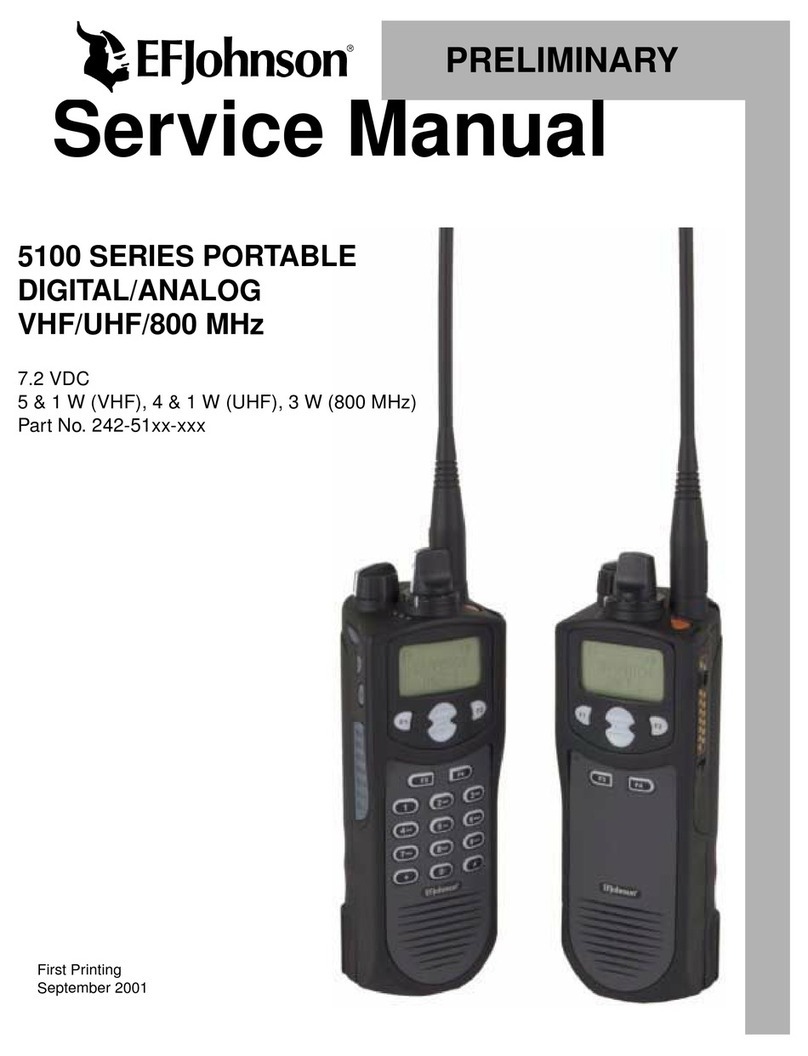
E.F. Johnson Company
E.F. Johnson Company 5100 Series User manual

E.F. Johnson Company
E.F. Johnson Company MULTI-NET 98xx SERIES User manual

